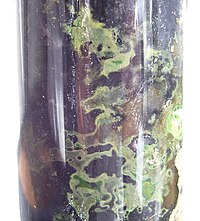
Photo from wikipedia
Cyanobacteria are major contributors to ocean biogeochemical cycling. However, mixotrophic metabolism and the relative importance of inorganic and organic carbon assimilation within the most abundant cyanobacteria are still poorly understood.… Click to show full abstract
Cyanobacteria are major contributors to ocean biogeochemical cycling. However, mixotrophic metabolism and the relative importance of inorganic and organic carbon assimilation within the most abundant cyanobacteria are still poorly understood. We explore the ability of Prochlorococcus and Synechococcus to assimilate organic molecules with variable C:N:P composition and its modulation by light availability and photosynthetic impairment. We used a combination of radiolabelled molecules incubations with flow cytometry cell sorting to separate picoplankton groups from the western tropical South Pacific Ocean. Prochlorococcus and Synechococcus assimilated glucose, leucine and ATP at all stations, but cell-specific assimilation rates of N and P containing molecules were significantly higher than glucose. Incubations in the dark or with an inhibitor of photosystem II resulted in reduced assimilation rates. Light-enhanced cell-specific glucose uptake was generally higher for cyanobacteria (∼50%) than for the low nucleic acid fraction of bacterioplankton (LNA, ∼35%). Our results confirm previous findings, based mainly on cultures and genomic potentials, showing that Prochlorococcus and Synechococcus have a flexible mixotrophic metabolism, but demonstrate that natural populations remain primarily photoautotrophs. Our findings indicate that mixotrophy by marine cyanobacteria is more likely to be an adaptation to low inorganic nutrient availability rather than a facultative pathway for carbon acquisition.
Journal Title: Environmental Microbiology
Year Published: 2018
Link to full text (if available)
Share on Social Media: Sign Up to like & get
recommendations!